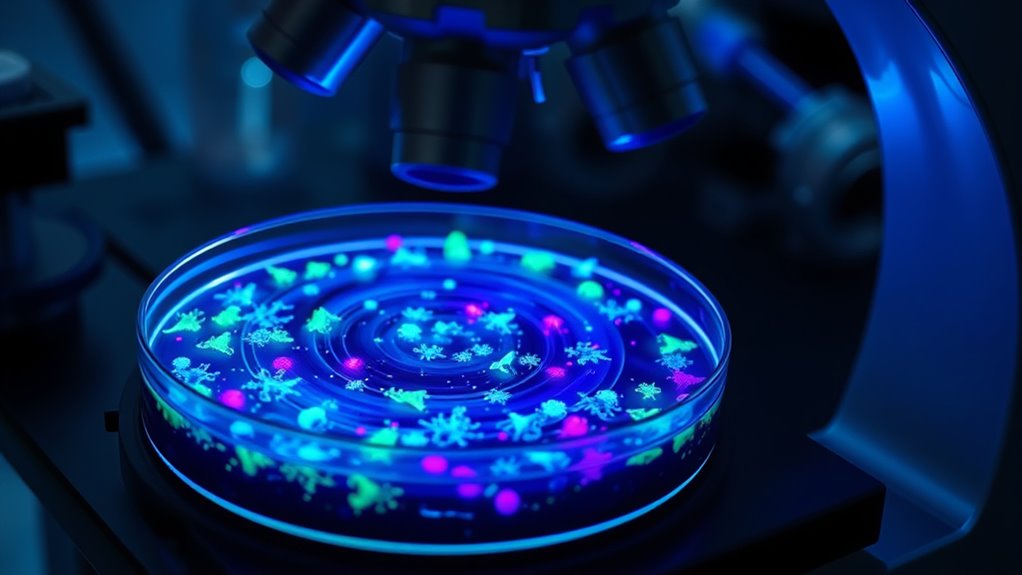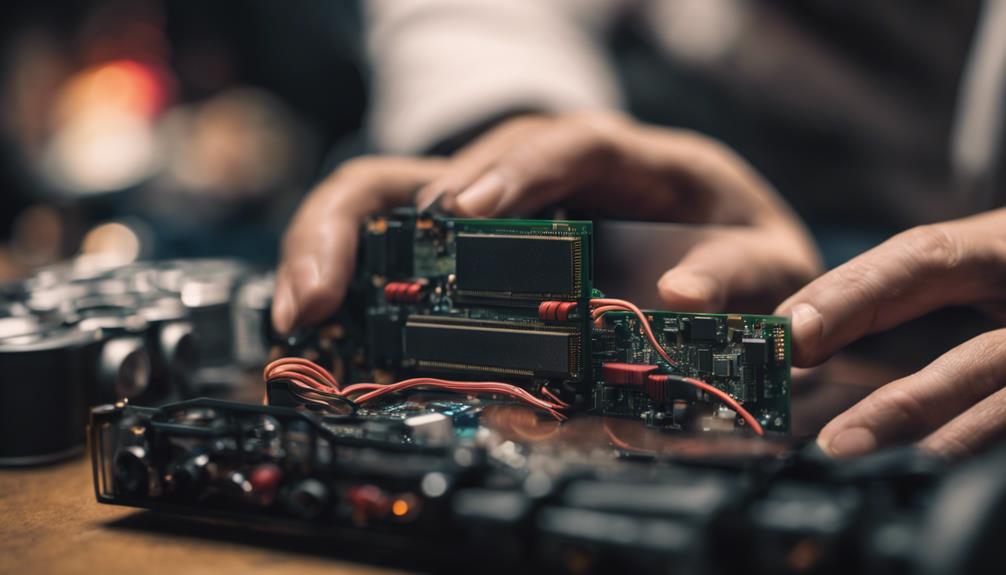Yes, scientists are debating whether microbes could kickstart Mars’s transformation into a livable world. Researchers believe that engineered microbes could modify Mars’s atmosphere, produce essential gases like oxygen and methane, and help create the soil needed for plant life. This microbial approach offers a faster, scalable alternative to traditional methods. If you’re curious about how microbes might reshape a planet and the challenges involved, there’s more to uncover about this innovative frontier.
Key Takeaways
- Microbes could initiate atmospheric and soil changes on Mars, making it more habitable over time.
- Genetic engineering enables microbes to survive Mars’s extreme conditions and produce essential gases like oxygen and methane.
- Using microbes offers a potentially faster, scalable approach compared to traditional terraforming methods.
- Scientists debate risks of uncontrollable microbial spread and ecological disruption versus potential benefits.
- Microbial terraforming is viewed as an initial step, with ongoing ethical, environmental, and technical considerations.

Have you ever wondered how scientists might transform the red planet into a livable world? One of the most intriguing ideas revolves around biosphere creation through microbial engineering. This approach involves introducing specially designed microbes to Mars’s harsh environment, with the goal of gradually altering its atmosphere, surface, and climate to support life. This process could serve as a scientific foundation for more extensive terraforming initiatives in the future. Instead of waiting centuries for conventional terraforming methods, researchers believe microbes could be the initial step toward making Mars more Earth-like. The concept is simple in theory but complex in practice: these microbes would perform essential functions such as releasing gases, producing nutrients, and even assisting in soil formation, all of which are indispensable for establishing a sustainable biosphere.
Microbial engineering plays a central role in this process. Scientists are developing microbes that can survive extreme conditions—intense cold, low oxygen levels, high radiation—and still carry out fundamental biochemical processes. These microbes could be genetically modified to produce greenhouse gases like methane or oxygen, helping to thicken the atmosphere and warm the planet naturally. The idea is to deploy these engineered microorganisms in targeted regions, where they can start transforming the environment from the ground up. Over time, their metabolic activities could generate a more hospitable climate, paving the way for larger plants and eventually human colonization. Additionally, advances in space microbiology are enabling researchers to better understand how microbes behave in extraterrestrial environments, which is crucial for this initiative. This research also helps inform planetary protection protocols to prevent contamination of extraterrestrial ecosystems. Furthermore, understanding microbial resilience is essential to ensure these microbes can endure Mars’s extreme conditions without failure. Moreover, ongoing studies into microbial adaptability provide insights into how these organisms could evolve alongside changing Martian environments, increasing their effectiveness and safety.
Engineered microbes could survive Mars’s harsh conditions to help build a breathable atmosphere and support future colonization.
However, this approach raises important questions. How do you guarantee that the microbes don’t become uncontrollable or disrupt potential native ecosystems? What are the risks of unintended consequences—like creating harmful byproducts or failing to achieve the desired atmosphere? Researchers are carefully debating these issues, emphasizing the need for rigorous containment strategies and ecological assessments. Still, microbial engineering offers a promising, scalable way to initiate biosphere creation on Mars, potentially making the planet’s environment more suitable for life in the long run.
This microbial approach doesn’t aim to instantly transform Mars into Earth, but rather to lay the groundwork for future terraforming efforts. It’s about starting small—using microbes as biological tools to engineer the planet’s atmosphere and surface. If successful, this strategy could drastically reduce the time and resources needed for traditional terraforming methods. While challenges remain, the idea of harnessing microbes to kick-start Mars’s transformation captures the imagination of scientists and space enthusiasts alike. It’s a bold step toward turning the red planet into a new frontier for life and human exploration.
Frequently Asked Questions
How Long Would It Take for Microbes to Significantly Alter Mars’ Environment?
The timeframe estimation for microbes to substantially alter Mars’ environment depends on microbial adaptation and environmental factors. You’d need to consider how quickly microbes can survive and reproduce in harsh conditions. While some suggest changes could begin within decades, full terraforming might take centuries or longer. Microbial adaptation plays an essential role, as resilient microbes could accelerate ecological shifts, but predicting exact timelines remains complex due to numerous variables at play.
Are There Any Specific Microbes Best Suited for Martian Conditions?
Think of microbe selection like finding the perfect puzzle piece for a complex picture. You’d need microbes that can adapt quickly to harsh Martian conditions, showing remarkable microbial adaptation. Extremophiles, such as certain bacteria and archaea, are prime candidates because they thrive in extreme environments on Earth. These microbes could potentially survive and even modify Mars’ environment, making them ideal for early terraforming efforts.
Could Microbes Unintentionally Harm Potential Future Martian Ecosystems?
You should consider that microbes might unintentionally harm future Martian ecosystems through microbial contamination, which could introduce invasive species or disrupt native conditions. Such ecosystem disruption could hinder natural processes or make the environment less hospitable for future life forms. Careful precautions are essential to prevent these risks, ensuring that any microbial activity supports sustainable terraforming efforts without causing irreversible harm to the planet’s evolving ecosystem.
What Are the Ethical Considerations of Introducing Earth Microbes to Mars?
Imagine planting a seed in unknown soil, unsure if it’ll flourish or destroy. You must consider planetary ethics and microbial sovereignty when introducing Earth microbes to Mars. You hold the power to shape a new world, but also bear responsibility for its future. Carefully weigh the risks of disrupting Mars’s natural state versus the promise of creating life. Your choices could echo across cosmic history, so act with wisdom and respect.
How Do Scientists Monitor Microbial Activity During Planetary Terraforming?
You monitor microbial activity during planetary terraforming by tracking microbial adaptation and detecting planetary biosignatures. You use advanced sensors and instruments to observe changes in microbial populations and their metabolic processes. Regular sampling helps you identify biosignatures, indicating life activity or environmental shifts. This ongoing monitoring guarantees that microbial growth aligns with your terraforming goals and helps you assess how microbes influence Mars’ evolving environment.
Conclusion
As you consider the promise of microbes shaping Mars’s future, remember that even the smallest life forms hold the potential to gently awaken a new world. While uncertainties linger like quiet shadows, hope whispers that with patience and care, we can nurture a delicate beginning. Perhaps, in time, these tiny pioneers will softly pave the way for a thriving, vibrant planet—reminding us that great change often starts with the humblest of steps.
Amina brings over a decade of journalism experience to her role as Editor-in-Chief. Under her leadership, Exquisite Post has flourished, maintaining the highest standards of integrity and excellence. Amina’s commitment to truth and her visionary approach guide the editorial team in producing impactful news stories that resonate with our audience.









